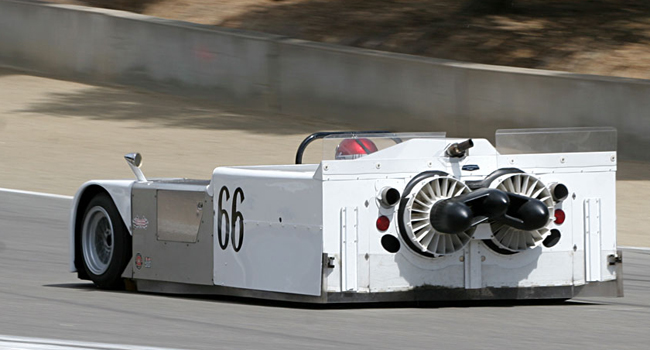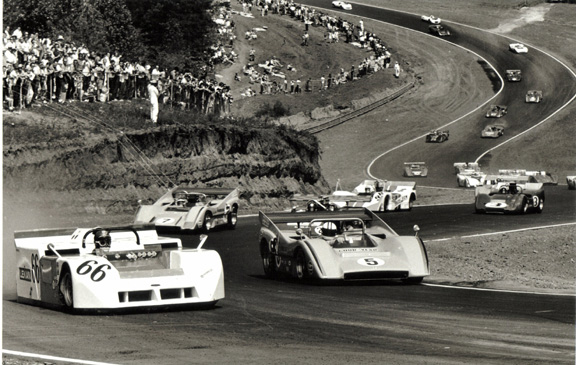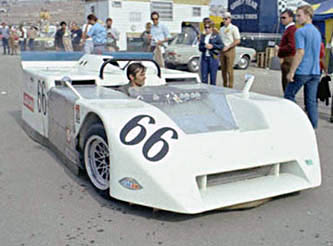The Chaparral 2J is one of those cars that raises an interesting question. Can a race car be considered a failure if it works too well? Read this story of a wildly innovative car and decide for yourself.
By 1970, Jim Hall, a Texas oil man and pretty swift engineering mind, had been building his Chaparral race cars since 1961. Over that nine-year span he had earned a reputation for innovation, out-of-the-box thinking, and successful, if not odd-looking cars in comparison to other of the day. Hall was one of the first guys to really apply the forces of aerodynamics to road racing cars, especially in the wild and rollicking Can-Am racing series in North America.
Most racing aficionados know the Chaparral 2E off the top of their heads. That’s the sleek, sexy-bodied racer with the massive wing on stanchions sitting above the driver. That wing was adjustable and the driver of the car played an active role in its effectiveness as they would flatten the wing on the straights and angle it up for the corners to add grip. The car was mocked when it first debuted because frankly it looked ridiculous, but like all things, once it was proven to work, the jokes stopped.
As Hall’s designs progressed, so did his understanding and use of aero tricks and ideas. What was looking like his crowning work, the 2H, a beautiful sculpted body that was the aerodynamic trick, was, in short, a flop. Driven by John Surtees, the car never really got sorted out and Surtees quit the team before the 1969 season’s conclusion. It has been written that the car worked so well in the aero department that it was forcing itself up on two wheels in the corners. That may explain Surtees’ departure and the reason it was wrecked by a replacement driver at the final race of the 1969 season in practice.
By all accounts, Hall was upset and embarrassed by the 1969 campaign. The 2J he returned to Can-Am competition with in 1970 seems to be proof of that. He pulled out all the stops and unveiled a car that stupefied everyone.
With all he had learned about wings, and other tack-on aerodynamic doodads one would expect this car to be chock full of them. Instead there were none. In the place of the wings was a 45hp Rockwell snowmobile engine, two large fans, some ground effects, and a lot of confused competitors. Jim hall gave up on finding downforce and in a stroke of brilliance, decided to create his own.
That snowmobile engine ran at full steam, spinning those big fans and drawing air out from underneath the car, sucking it down to the ground. What couldn’t be seen were the ground-effect skirts that were attached to the suspension of the car creating the virtual seal to the asphalt at all times. Lexan was brand new stuff at that time and this car wore its name on its flanks.
We hear about F1 cars that could “drive upside down at 200 mph” due to the amount of downforce they generate, by a completely different (and totally ingenious) method, Hall could make wild ass claims like those 40 years ago!
The chassis of the car was moncoque and made of aluminum. Learning from the problems of the 2H the car was made wider. Hall was working on the concept that the wider car would be far less susceptible to lift side to side than the narrower 2H. As we will see later, he was totally correct in this assumption.
Heading back to our American muscle roots here, one of the shining points of this car is the fact that it was powered, like so many other Can-Am racers, by an American V8. This one happened to be an all-aluminum, fuel injected, 468ci big-block Chevy that made a reported 680 hp at a blazing 7,200 RPM. That’s pure Texas joy personified. Put all that power in a car that weighed 1,800 pounds and you’ve got yourself a bonafide rocket ship.
The other neat feature was a semi-automatic three-speed transmission that was a disadvantage on the starts, but proved its worth over the course of races. According to an interview Vic Elford, a man who actually raced one of the cars in competition, “It was a semi-automatic transmission, it wasn’t fully automatic. It had a three-speed transmission with a torque converter and a lock-up at 5,000 rpm. It was quite complicated to get it running. The steering column went down between your two feet so the left foot could only work the brake and the right foot could only work the gas pedal.”
Jim Hall hired Jackie Stewart, the high-profile Scot driver, to debut the car at the Can-Am event at Watkins Glen in 1970. Stewart qualified on the pole by a wide margin but was forced to retire early from the race with mechanical issues. The problem that would cause the car’s lack of podium success surfaced at that first race: the snowmobile engine. It died early on in the race and would be constant problem for the team during the season.
After taking off a few races to work the kinks out of the car, Hall was back, this time with Vic Elford behind the wheel. Elford put the car on the pole position again, this time with a margin of more than 2 seconds over the McLaren of Denny Hulme. Eyebrows were raised. Reports of the race state that at the start the McLarens blew by Elford, but by the second lap he had run right around them. During that race the snowmobile engine died again and Elford finished sixth.
Through our research we could not find any definitive reason why the snowmobile engines were not surviving, but we are going out on a limb and saying that oil starvation was killing them. It only makes sense with the extreme cornering forces involved.
After that qualifying effort, the noise started to rise from the pits. Although the car had shown itself to be unreliable, teams were realizing that once Hall got a handle on the combo it was going to be lights out. Competitors argued that the fans were “moving aerodynamic devices” which were banned by the FIA. The cries got loud enough for the FIA to listen and despite Hall’s best arguments the car was banned from competition, but not before being allowed to run the last race of the season
Vic Elford remembers running at Riverside, California, during the final event of the 1969 season: “Do you remember the old Riverside turn 9? It was a long, long, long fast 180-degree right-hander just before the pits. During practice I came up behind Denny (in the McLaren M8D-Chevrolet) on the way into that corner and it was a very fast corner. Not quite flat but for me very close to it, and I remember driving around the outside of Denny (laughing) and he just pulled off into the pit lane absolutely pissed off! He took his helmet off and sat on the pit wall and sulked for the rest of the practice session. I had beaten his time by about 2.5 seconds.”
The car suffered yet another fan motor failure and finished the race “out of the money.” It was the last time the car would ever see true competitive action. Hall held onto the car and it has seen action at vintage races and events in years past.
So this was a car that would have and could have been a game changer if not for the lobby of fellow competitors that didn’t want to face the fact they were sitting in obsolete cars.
Imagine if the NHRA had done the same thing with Garlits’ dragster!

























